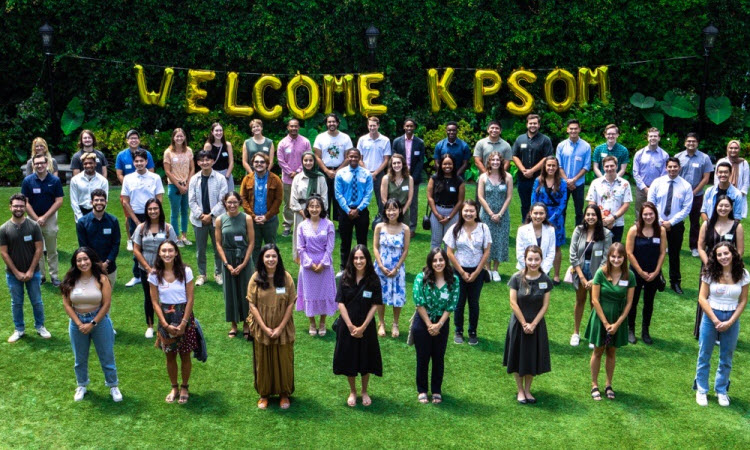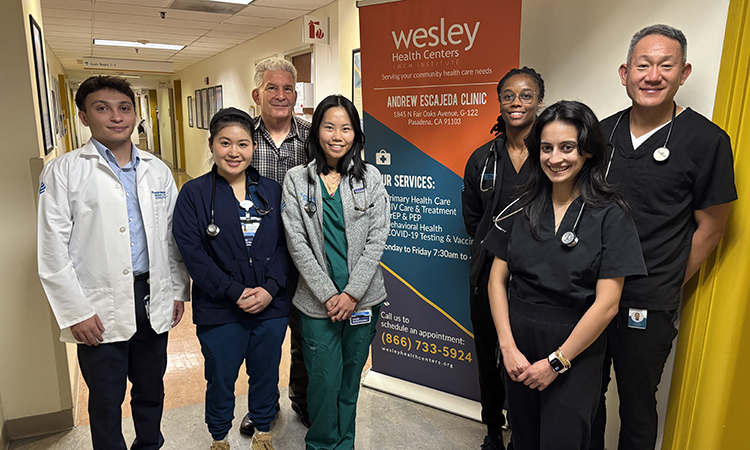The Kaiser Permanente Bernard J. Tyson School of Medicine (KPSOM) officially welcomed its second 50-member student class to campus over the July 24-25 weekend. The festivities began with guided tours of the school’s Medical Education Building in Pasadena, which will serve as the students’ home base on their journey toward becoming outstanding physicians and advocates for change within the medical profession and society. The following day, students met each other, members of the leadership team, and the student affairs team at a welcome event at the nearby Altadena Town & Country Club. All events followed COVID-19 safety protocols in force at the time.
“The class of 2025, like our inaugural class, is deeply compassionate, diverse, and intellectually curious,” said Mark Schuster, MD, PhD, Founding Dean and CEO of KPSOM. “We are thrilled to welcome them as they embark upon their medical school journey.”
The second class began their formal studies on Monday, July 26, with the Early Immersive Experience (EIE) course. The three-week course introduces students to the school’s INSPIRE curriculum, support services, and their REACH (Reflection, Education, Assessment, Coaching, and Health and well-being) coaches, who help students set and pursue professional goals, and build resilience skills, throughout their time at the school. Students are also taught foundational patient care skills to prepare them for early clinical experiences at Kaiser Permanente medical sites beginning in the third week of their medical education.
“I’m excited to start on the doctoring course and interact with Kaiser Permanente physicians and patients through my longitudinal integrated clerkship site,” said May Let Wah, a member of the new class. “I am looking forward to community building and making connections with my classmates.”
Getting into medical school this year was even more challenging than usual given a nationwide surge in applicants inspired, in part, by the COVID-19 pandemic. According to data from the Association of American Medical Colleges, nearly two dozen medical schools saw applications jump by at least 25 percent in 2020. And KPSOM, with a class size of just 50 for its inaugural class, had the highest ratio of applicants to available spots for the first year of recruitment, yielding an admission rate that was the lowest among allopathic medical schools at just 0.5 percent.
KPSOM’s focus on addressing healthcare disparities, which the pandemic has made even more apparent, was a major draw for Olivia Goodman, a member of the new class.
“The school’s mission to work at the intersection of public health and medicine spoke to me and my goals. The promotion of health equity through quality patient care is of the utmost importance. I want to dedicate my career to this aspiration,” she said.
The school has waived tuition for its first five classes entering 2020 through 2024, for all four years of their education, to help ease the financial burden of attending medical school and encourage students to choose career paths unencumbered by significant debt loads incurred in medical school. This also enables KPSOM to recruit and admit a diverse student body, including those who may have previously thought medical school to be beyond their financial means.
The class of 2025, similar to the inaugural class, reflects the school’s mission to educate physicians from a diverse range of backgrounds who will become outstanding clinicians and skilled advocates for the health and well-being of their patients and communities. Dimensions of diversity include but are not limited to a wide range of life experiences, racial identities, ethnicities, sexual orientations, gender identities, disabilities, nationalities, religious/spiritual/secular identities, veteran/military affiliate statuses, and socioeconomic backgrounds.
Among the 50-member class, 40 percent come from groups underrepresented in medicine; two students are in the Deferred Action for Childhood Arrivals program; 30 percent self-identify as members of the LGBTQ community; and more than 26 percent come from socioeconomically disadvantaged backgrounds. In addition, students who are their first in their families to complete a four-year degree make up 18 percent of the class, with non-traditional students ─ those aged 25 or over, career changers, and others who have had a circuitous journey to medical school ─ accounting for 34 percent.
“We are looking forward to what the next year holds for the school as we continue to build a radically inclusive community for students, staff, and faculty,” said Anne Eacker, MD, Senior Associate Dean for Student Affairs. “We want to be welcoming to all, practicing cultural humility, and approaching each other with genuine curiosity. We strive to create a community where everyone can show up as their authentic selves, and where our students can continue to integrate their social identities into their evolving professional identity as a future physician.”



.jpg)